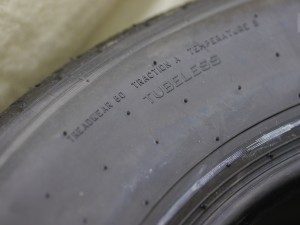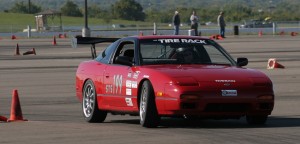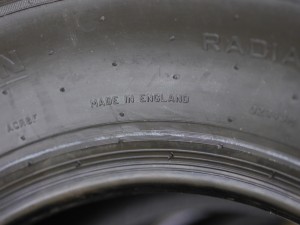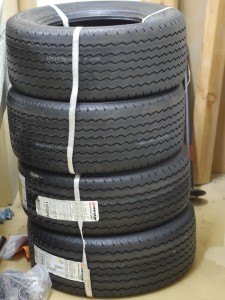The car’s first set of tires
If you’ve followed along in my Comparative Vehicle Dynamics series, and you didn’t already know, you’ll no doubt come to the conclusion, that tires are an extremely important, if not the most important, part of a race car.
My 2006 run in the STS class was fueled largely in part by the availability of (for the time) next-generation tires for my 17″ wheel, 25″ diameter tire’d 240sx, vs. their 15″ wheel, 23″ diameter Civics. I’d had the chance to experience one of these tires (Yokohama Advan Neova AD07) the year before on an IS300, and knew they held a real edge over the Falken RT-215 still popular on STS Civics. I found I was even faster on the Bridgestone Potenza RE-01R released in 2006, even if I didn’t like the feel of the tire as much, as the Yokohama.
The point of all this, was the 240sx was a fun, but rather expensive experiment, where the hypothesis went something like “A car that has no business doing well, can not only be competitive, but possibly win in Solo, due to a small tire advantage”. I think this hypothesis was proved correct even if it wasn’t the fastest both days – besides, the 240Ssx ran away with the ProSolo win, as it was able to take advantage of its other strengths – namely RWD and torque.
So, tires matter a lot, and if there’s one place you can give yourself a meaningful advantage, it’s there. Chasing every last HP and ounce of weight are also useful pursuits, but in almost any case, I’d give those up to get a tire edge.
But unfortunately, there are only so many tires out there. The leading edge street tires are focused enough in their development, the odds of finding a ringer, that through some weird trick, happens to outperform 2012’s usual suspects (Toyo R1R, Yok AD08, Bridgestone RE-11, Dunlop Star Spec, Hankook RS3, Kumho XS, and now the Michelin PSS) is pretty much nonexistent. Plus the STAC wisely toughened the entry requirements for ST tires, mandating they be available in the same diameter/size counts as Stock-legal tires, which eliminated possible ringers like the Nissan GTR and Ford GT500 OEM tires.
As of this writing I don’t really have a good sense for where I’ll be going with the race tires for this car. Looks like there’s more coming out in the off season, so 2013 stands to be a lot different than the past couple years, in the tire makeup in grid.
It does look like I’ll need to run 18″ wheels though. I for sure want to run the class-max width size (265) and most manufacturers only offer that width in 18″ diameter. While this size defies the vintage look of the car, it does allow for a lot of additional backspacing in the front, making it easier to fit the tires. With 15″ wheels, I appear to only have about 4.25″ of backspace room, before the wheel would hit the steering arm. With 18″ wheels, I’m aiming for more like 5.25″ of backspace.
I do have some 18″ wheels on the way. They’ve been a work in progress the last several weeks, at a small race wheel shop here in California. If I’d gone with CCW I’d probably have received my wheels weeks ago, as Purner is so solid on turn-around times, but even though I’m going 18″ for race wheels, I wanted to go with a style that at least tried to look vintage. Purner’s stuff, even the “classic”, all felt a bit too modern for the car. Hopefully the style I’ve picked for this first set looks good, the wheel maker is so low volume, there are very few of his wheels out in the wild.
In all this research of tire and wheel makers, and looking at the universe of first-gen Camaros out there, I decided I pretty much hate every large diameter (>16″) wheel that’s been put on these cars. Some look less awful than others, but the styles are all so modern, they just seem to contradict the rest of the car. And it’s not just the wheels, the tire sidewall is a big part of it too. A modern 265/35-18 tire is about 25.5″ tall, with a sidewall height of only 3.6″. A vintage 7.00-15 Goodyear Blue Streak, is 26.7″ in diameter, with a sidewall almost 6″ tall.
If I’m working to make the car competitive in SCCA autocross, I’m going to run the best tire for the car I can, which means running the correct diameter wheels, which means probably not running on the car in autocross, what I think looks best, or suits the car best. Lots of work has gone into making the car look the way I want, and I was careful to allow backwards-compatibility with vintage-sized 15″ wheels. My interest in pursuing a vintage set of wheels and tires was piqued recently, when I came across a thread discussing vintage racing tires for Cobras.

In it, many people spoke highly of a certain model Avon tire – the CR6ZZ. Available in tall sidewall sizes, but built with modern techniques and knowledge. Great on the track once warmed up, great in the wet, and fun on the street, with many people getting over 10,000 street miles in their hot rods. Only downside is cost – one set of 245/60-15 (front) and 275/55-15’s (rear) cost more than the last set of 335/30-18 and 345/30-19 Hoosier A6’s I bought for the Viper.
I figure these will last a lot longer than those A6’s – the Camaro isn’t likely to get many street miles, so these things are likely to die of old age before being worn out. Of course they supposedly they make great track tires, so they may see some use in that capacity as well. Ironically, since they are Treadwear 80 tires, I won’t be able to run them STX, even if I hadn’t gone with the wide 275 rear tire.
The wheels for these tires are a very special set, made by an even smaller wheel company than the one doing my 18″ wheels. This latter company, makes a lot of the wheels used by real vintage racers, the guys running the original Trans-Am and Can-Am cars at events like the Monterey Historics. Even when narrowing my search of wheels to original style and size 15″ Minilites and Torq-Thrust wheels, nothing available new today from the regular makers seemed to look right, except these guys. They just so happened to have four in their inventory, normally I’d have to wait 6-8 months to get a set, but instead I should have them soon.
Hope to get the car on the ground soon, on this vintage style wheel/tire setup. I’ve had the car sitting with jackstands under the suspension to try to get things to settle a bit, but the rear is still about 3″ too high, and there’s not much weight left to put in that’ll drop it, save for fuel.



Leave a Reply
You must be logged in to post a comment.